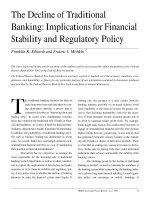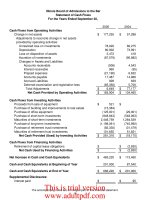Academic press handbook of digital currency bitcoin innovation financial instruments and big data may 2015
Bạn đang xem bản rút gọn của tài liệu. Xem và tải ngay bản đầy đủ của tài liệu tại đây (6.14 MB, 613 trang )
HANDBOOK OF
DIGITAL CURRENCY
HANDBOOK OF
DIGITAL CURRENCY
Bitcoin, Innovation, Financial
Instruments, and Big Data
Edited by
DAVID LEE KUO CHUEN
Sim Kee Boon Institute for Financial Economics, Singapore Management
University, Singapore
AMSTERDAM • BOSTON • HEIDELBERG • LONDON
NEW YORK • OXFORD • PARIS • SAN DIEGO
SAN FRANCISCO • SINGAPORE • SYDNEY • TOKYO
Academic Press is an imprint of Elsevier
Academic Press is an imprint of Elsevier
125 London Wall, London, EC2Y 5AS, UK
525 B Street, Suite 1800, San Diego, CA 92101-4495, USA
225 Wyman Street, Waltham, MA 02451, USA
The Boulevard, Langford Lane, Kidlington, Oxford OX5 1GB, UK
© 2015 Elsevier Inc. All rights reserved.
Chapter 14, How to Tax Bitcoin? © 2015 Aleksandra Bal. Published by Elsevier Inc. All rights reserved.
No part of this publication may be reproduced or transmitted in any form or by any means, electronic or mechanical,
including photocopying, recording, or any information storage and retrieval system, without permission in writing from
the publisher. Details on how to seek permission, further information about the Publisher’s permissions policies and our
arrangements with organizations such as the Copyright Clearance Center and the Copyright Licensing Agency, can be
found at our website: www.elsevier.com/permissions.
This book and the individual contributions contained in it are protected under copyright by the Publisher (other than as
may be noted herein).
Notices
Knowledge and best practice in this field are constantly changing. As new research and experience broaden our
understanding, changes in research methods, professional practices, or medical treatment may become necessary.
Practitioners and researchers must always rely on their own experience and knowledge in evaluating and using any
information, methods, compounds, or experiments described herein. In using such information or methods they should be
mindful of their own safety and the safety of others, including parties for whom they have a professional responsibility.
To the fullest extent of the law, neither the Publisher nor the authors, contributors, or editors, assume any liability for any
injury and/or damage to persons or property as a matter of products liability, negligence or otherwise, or from any use or
operation of any methods, products, instructions, or ideas contained in the material herein.
Library of Congress Cataloging-in-Publication Data
A catalog record for this book is available from the Library of Congress
British Library Cataloguing in Publication Data
A catalogue record for this book is available from the British Library
For information on all Academic Press publications
visit our website at />ISBN: 978-0-12-802117-0
Publisher: Nikki Levy
Acquisition Editor: J. Scott Bentley
Editorial Project Manager: Susan Ikeda
Production Project Manager: Nicky Carter
Designer: Matthew Limbert
Typeset by SPi
Printed and bound in the USA
DEDICATION
This book is dedicated to Noreen and Herman Harrow.
CONTRIBUTORS
Christian Bach
Swiss Economics, Zurich, Switzerland
Aleksandra Bal
International Bureau for Fiscal Documentation, Amsterdam, The Netherlands
Nirupama Devi Bhaskar
Sim Kee Boon Institute for Financial Economics, Singapore Management University,
Singapore
David G.W. Birch
Consult Hyperion, Guildford, Surrey, UK
Aeron Buchanan
Ethereum Foundation, Switzerland
Kim-Kwang Raymond Choo
University of South Australia, Adelaide, South Australia, Australia
Anton Cruysheer
ABN AMRO Bank, Amsterdam, The Netherlands
Primavera De Filippi
CERSA/CNRS/Universite´ Paris II–Berkman Center for Internet & Society at Harvard Law
School, Cambridge, Massachusetts, USA
Christian Jaag
Swiss Economics, Zurich, Switzerland
Alyse Killeen
March Capital Partners, Santa Monica, California, USA
Andras Kristof
Tembusu Terminals, Singapore
David LEE Kuo Chuen
Sim Kee Boon Institute for Financial Economics, Singapore Management University, Singapore
Teik Ming Lee
Sim Kee Boon Institute for Financial Economics, Singapore Management University,
Singapore
Richard B. Levin
Bryan Cave, LLP, Denver, Colorado, USA
Guo Li
Sim Kee Boon Institute for Financial Economics, Singapore Management University,
Singapore
xvii
xviii
Contributors
Jonathan W. Lim
National University of Singapore Centre for Banking and Financial Law, Singapore, and Wilmer
Cutler Pickering Hale & Dorr (WilmerHale) LLP, London, UK
Ignacio Mas
Saı¨d Business School, University of Oxford, Oxford, UK
Ralph E. McKinney, Jr.
College of Business at Marshall University in Huntington, West Virginia, USA
Andrew Newman
University of New South Wales, Sydney, New South Wales, Australia
Lam Pak Nian
Sim Kee Boon Institute for Financial Economics, Singapore Management University, Singapore
Pierre Noizat
Co-founder of Paymium, Bitcoin Exchange and provider of e-commerce solutions, Paris, France
Aaron A. O’Brien
Baker & Hostetler, LLP, PNC Center, Cleveland, Ohio, USA
Bobby Ong
Sim Kee Boon Institute for Financial Economics, Singapore Management University, Singapore
Georgios Papadopoulos
Erasmus University Rotterdam, Rotterdam, The Netherlands
Duane C. Rosenlieb, Jr.
Rosenlieb Law Office, St. Albans, West Virginia, USA
Tetsuya Saito
Nihon University, Tokyo, Japan
Gideon Samid
Case Western Reserve University, Cleveland, Ohio, USA
Vrajlal Sapovadia
Shanti Business School, Ahmedabad, India
Dale H. Shao
College of Business at Marshall University in Huntington, West Virginia, USA
Lawrence P. Shao
College of Business at Marshall University in Huntington, West Virginia, USA
Matthias Tarasiewicz
University of Applied Arts Vienna, Vienna, Austria
Ernie G.S. Teo
Sim Kee Boon Institute for Financial Economics, Singapore Management University, Singapore
Nicolas Wesner
Mazars Actuariat, Paris, France
Gavin Wood
Ethereum Foundation, Switzerland
Contributors
David Yermack
New York University Stern School of Business, New York, New York, and National Bureau of
Economic Research, Cambridge, Massachusetts, USA
Madiha M. Zuberi
Baker & Hostetler, LLP, New York, New York, USA
xix
PREFACE AND ACKNOWLEDGMENTS
The year 2008 has left a deep and lasting impression on the Millennials, also known as the
Millennial Generation who are born in the early 1980s to early 2000s. It was the year of
the financial market crash that started in the United States and soon spilled over to Europe
and Asia, thereby triggering the global financial crisis in a time-compressed manner.
While governments responded with unprecedented monetary policy expansion and fiscal
stimulus, many Millennials have to contend with high unemployment and scarce economic opportunities at a time when they are establishing their careers. But few realize
their lives have been shaped not only by happenings in Wall Street and Main Street
but also by technology. They will remember 2008 as the beginning of the peer-to-peer
decentralized cryptocurrency called the Bitcoin protocol. The white paper by Satoshi
Nakamoto first appeared on the Internet via the Cryptography Mailing List in November
2008 (archived in />msg09959.html) after the global financial crisis as a significant contribution to the world
without actually first being published in an academic journal.
Since then, the white paper ( has generated a lot of
interest. First, the timing of the release was a direct response to a crisis of confidence
in a reserve currency, and there was no better time than 2008. Faced with an era of disquiet and a gradual loss of trust in the fiat currency system introduced in 1971, as well as
the prospect of massive printing of money known as quantitative easing, the white paper
offers a set of feasible alternative solutions to those who have little faith in a centralized
monetary system. Cryptocurrency was first introduced in the early 1990s by an academic
entrepreneur David Chaum in the form of eCash and DigiCash. The National Security
Agency released an analytic report of great significance on the same subject over the
Internet in 1996. But few in the financial world paid much attention to the development
of cryptocurrency until the global financial crisis. It only caught the attention of many
financial experts when successive quantitative easings pushed up asset prices. Given that
the reversal of quantitative easing has unknown consequences and that China has started
its bilateral swap agreements, the BRICS Development Bank and the Asian Infrastructure
Investment Bank begin to challenge the conventional international institutions, and
interest has begun to center on alternative monetary systems that include the digital currency system. Cryptocurrency, a special class of digital currency, continues to generate
interest among those who are uncomfortable with national currency beleaguered by huge
liability, rather than backed by assets, of some central governments.
Second, the white paper of Satoshi was the first paper that proposed a distributed
monetary system and challenged the central authority that controlled money supply.
xxi
xxii
Preface and Acknowledgments
The proposed system was designed to address some of the issues that a centralized system
could not. In particular, the control was decentralized and the supply of money was predetermined. Given the open-source nature of the Bitcoin protocol, there are too many
participants for anyone to effectively monitor and regulate single-handedly. For the first
time, governments realize the decentralized nature poses great problems for anyone who
intends to regulate a legal entity or small number of entities, let alone to hold them
responsible for any wrongdoing.
Third, there are a lot of unanswered questions about the Bitcoin system, thus creating
curiosity among those who follow the development. In particular, the identity of the creator or group of creators of Bitcoin remains a mystery. While there have been many
attempts to uncover the mystery surrounding Mr. Nakamoto, including at least one hacker
who claimed to know the identity of Mr. Nakamoto after gaining access to his e-mail
account, Mr. Nakamoto’s identity is still unknown to the public. The mysterious nature
surrounding Bitcoin has generated even more following. The community remains amazed
at the foresight of the creator(s) and respects the reason for remaining under the radar.
Fourth, the Bitcoin invention has put regulators on the spotlight. Any attempt to regulate the cryptocurrency protocol has proved to be extremely difficult. However, regulators have managed to study the issues carefully in regulating the intermediaries and
have focused in the areas of consumer protection, antimoney laundering, and counterterrorist financing. The balance between regulation and entrepreneurship has proved to
be most challenging to achieve. This has therefore attracted a lot of attention from tax
authorities, central bankers, and crime busters. Never before has technology invention
attracted so much attention and posed so many challenges as it involves international
finance, monetary system, and innovative financial technology with cyber security.
Fifth, the income and wealth inequality of the world has risen rapidly since the quantitative easings. With six times wealth-to-income ratio, the highest since the late 1930s,
governments are focusing on financial inclusion. Bitcoin provides a cheap form of payment
system and that possibility has brought cryptocurrency into the limelight as an alternative
payment system. Organizations such as Bill and Melinda Gates Foundation have made
payment systems as one of its priorities, together with the Maya Declaration initiated by
the Alliance for Financial Inclusion. We can see that Bitcoin will share the limelight of those
serving the 2.5 billion unbanked and attracting the attention of those who are engaged in
impact investing as advocated by the Global Impact Investing Network. Both financial
inclusion and impact investing are areas of great interest and cryptocurrency is in the
right space.
Sixth, cryptocurrency has contributed to innovation and we have seen many interesting developments. It is said that the best brains are in cryptocurrency because it is not
only a currency but also a form of programmable money. The developers will be able to
program in a way to serve the purpose intended. These innovations include smart
accounting, smart contract, crowdsourcing, crowd funding, crypto-equity, and many
Preface and Acknowledgments
others that can change the way business is done and managed. Consensus ledger, digital
register, Blockchain are a emerging class of technology for the future. It is likely that there
will be acceleration in the development of Bitcoin 2.0, blockchain 2.0, and sidechains,
with new development only limited by our imagination.
Seventh, the emergence of the digital natives and smart cities has generated even more
interest in the development of cryptocurrency. Cities such as Singapore will have its
entire country connected to the digital world, with projected growth coming from
the digital economy. Its citizens will be natives to the digital world. The technology that
is developed in the cyberspace will be of great interest in these countries that spend millions or billions in getting the infrastructure up for a digital economy. Incentives for startups will get more interesting and the majority of the investment will certainly be focused
on cyber security and connectivity, and that will involve investment in encryption, financial cryptography, decentralized storage, and mobile payments. Cryptocurrency will of
course be of great interest given that it leads innovation in securing the payments, decentralized ledger, and encryption.
Given the interest in cryptocurrency, it is not surprising that there was encouragement all-round to start an interesting project on digital currency with special emphasis
on cryptocurrency. The foresight of Scott Bentley, who saw the potential of this project,
and McKenna Bailey’s strong support motivated me to start working on the book in early
2014. I thank Elsevier for their encouragement and support. The title “Handbook of
Digital Currency: Bitcoin, Innovation, Financial Instruments, and Big Data” was chosen
to convey the idea that the focus is on Bitcoin, Bitcoin 2.0, and associated innovations.
This book would not have been possible without the support of the Sim Kee Boon
Institute (SKBI) for Financial Economics, Singapore Management University. In particular, I would like to express my sincere appreciation to Mr. Lim Chee Onn, the chairman, and other advisers of the board, namely, Piyush Gupta, Magnus Bocker, Liew Heng
San, Tham Sai Choy, Ronald Ong, Lim Cheng Teck, Aje Saigal, Sunil Sharma, Tan
Suee Chieh, Jacqueline Loh, and Leong Sing Chiong, for their valuable counsel. The
authors who contributed to the book were mostly guest participants in the Inaugural
CAIA-SKBI Cryptocurrency Conference held at Singapore Management University
in November 2014 that saw a large turnout. I am grateful to them and all those who
had made extraordinary efforts to be at the conference. I would like to especially thank
Mikkel Larsen, Tim Swanson, Donald Chambers, Neal Cross, Andrew Koh, Norma Sit,
Gunther Sonnenfeld, Chan Hiang Taik, Ong Pang Thye, Jonathan Kok, Reuben
Branabahan, Iris Tan, Jason Tyra, Zann Kwan, Peter Peh, Scott Robinson, Anson Zeall,
David Moskowitz, and Andras Kristof for their vivacious participation in and substantial
contribution to the discussions. The vigor and rigor of the discussions at the conference
have spurred me to add new materials to the book. Peter Douglas of the Chartered Alternative Investment Association was instrumental in getting the conference going, and for
that, I could not thank him enough.
xxiii
xxiv
Preface and Acknowledgments
I am indebted to Professors Arnoud De Meyer, Rajendra Srivastava, and Gerry
George, the president, the provost, and the Dean (Lee Kong Chian School of Business)
of the Singapore Management University, respectively, who unstintingly supported the
research in this exciting area of cryptocurrency. The team at SKBI, especially Philip Foo,
Priscilla Cheng, and Elaine Goh was most helpful with their quiet efficiency in various
ways, including providing tireless administrative and logistical assistance in many sessions
of workshop from the cryptocurrency community. My colleagues Francis Koh, Casiopia
Low, Benedict Koh, Chan Soon Huat, Phoon Kok Fai, Phang Sock Yong, Enoch Chng,
Robert Deng, and Lim Kian Guan were always around encouraging me during the preparation of this book. My team of researchers Ernie Teo, Lam Pak Nian, Nirupama Devi
Bhaskar, and Guo Li worked hard to ensure the chapters were on time. A podcast on
some of the materials in this book was recorded with the help of Huang Pei Ling and
her team in October 2014.
I would like to thank my family for their encouragement and patience. I am grateful to
Koh Kheng Siong for introducing us to Noreen and Herman Harrow. This book is dedicated to the Harrows for taking care of my family and also giving me an opportunity to
compile this work in Monterey, thus allowing me to travel to Silicon Valley to harness
more ideas from the entrepreneurs and thought leaders in the field. Last but not least, to
thank God for revealing and guiding the mission.
I hope the materials in this book will add to the wealth of knowledge and research in
this exciting field and benefit those who read and use them.
David LEE Kuo Chuen
February 2015
Copyrighted Material
PART ONE
Digital Currency and Bitcoin
Copyrighted Material









